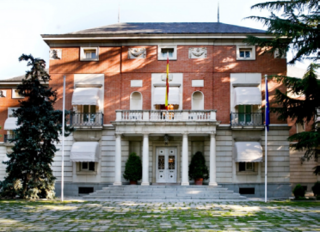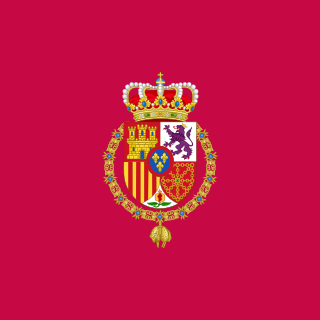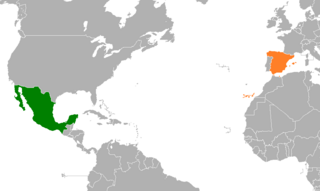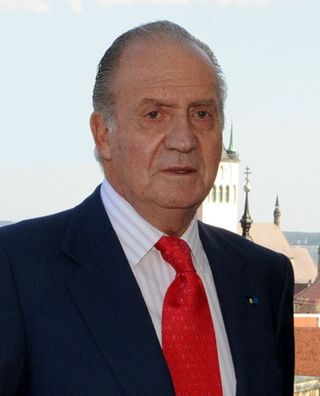Related Research Articles

Juan Carlos I is a member of the Spanish royal family who reigned as King of Spain from 22 November 1975 until his abdication on 19 June 2014. In Spain, since his abdication, Juan Carlos has usually been referred to as the rey emérito by the press.

Felipe VI is King of Spain. In accordance with the Spanish Constitution, as monarch, he is head of state and commander-in-chief of the Spanish Armed Forces, holding the military rank of Captain General, and also plays the role of the supreme representation of Spain in international relations.

The monarchy of Spain or Spanish monarchy is the constitutional form of government of Spain. It consists of a hereditary monarch that reigns as the head of state, being the highest office of the country. The current King is Felipe VI since 19 June 2014, after the abdication of his father, King Juan Carlos I.

The prime minister of Spain, officially president of the Government, is the head of government of Spain. The prime minister chairs the Council of Ministers and nominates its ministers; in these sense, the prime minister establishes the Government policies and coordinates the actions of the Cabinet members. As chief executive, the prime minister also advises the monarch on the exercise of their royal prerogatives.
Annus horribilis is a Latin phrase, meaning "horrible year". It is complementary to annus mirabilis, which means "wonderful year".

Letizia Ortiz Rocasolano is Queen of Spain as the wife of King Felipe VI.

Sofía is a member of the Spanish royal family who was Queen of Spain from 1975 to 2014 as the wife of King Juan Carlos I. She is the first child of Paul of Greece and Frederica of Hanover.
The King's Christmas message is a broadcast made by the sovereign of the United Kingdom and the other Commonwealth realms to the Commonwealth of Nations each year at Christmas. The tradition began in 1932 with a radio broadcast by King George V via the British Broadcasting Corporation's Empire Service. The message is broadcast on television, radio, and the Internet via various providers. It is usually broadcast at 15:00 GMT on Christmas Day. Unlike some other speeches, such as the King's Speech at the State Opening of Parliament which is written by the government, the Christmas speech is a personal message written by the monarch with input from spouses and direct advisors.

The Zarzuela Palace is the residence and working offices of the reigning monarch of Spain, although the official residence of the Spanish royal family is the Royal Palace of Madrid. The Zarzuela Palace is on the outskirts of Madrid, near the Royal Palace of El Pardo, which accommodates visiting heads of state. The palace is owned by the Spanish government and administered by a state agency named Patrimonio Nacional.

The Palace of Moncloa or Moncloa Palace is the official residence and workplace of the President of the Government, a position usually known in the English language as the Prime Minister of Spain. It is located in Puerta de Hierro Avenue, in the Moncloa-Aravaca district in Madrid. It has been the official residence of the Prime Minister since 1977, when Adolfo Suárez moved the residence from the Palace of Villamejor.
The Spanish royal family, a branch of the House of Bourbon, is headed by King Felipe VI, and currently consists of Queen Letizia, their children Leonor, Princess of Asturias and Infanta Sofía of Spain, and Felipe's parents, King Juan Carlos I and Queen Sofía. The royal family lives at the Zarzuela Palace in Madrid, although their official residence is the Royal Palace of Madrid. The membership of the royal family is defined by royal decree and consists of: the King of Spain, the monarch's spouse, the monarch's parents, his children, and the heir to the Spanish throne.

Leonor, Princess of Asturias is the heiress presumptive to the Spanish throne. She is the elder daughter of King Felipe VI and Queen Letizia.

The Royal Standard of Spain is the official flag of the King of Spain. It comprises a crimson square, traditional colour of both Castilian and Spanish monarchs, with the coat of arms of the King in the center. It is raised over the official royal residence in Madrid, the Palacio de la Zarzuela and other Spanish royal sites, when the monarch is in residence and displayed on his official car as small flag. The current flag was adopted when Felipe VI acceded the throne as King of Spain on 19 June 2014. The Royal Standard is regulated by Rule 2 of Royal Decree 527/2014, 20 June, an amendment to Title II of Spanish Royal Decree 1511/1977 adopting Flags, Standards, Guidons, Insignia and Emblems Regulation.

Princess Alicia of Bourbon-Parma was a Spanish infanta. A member of the House of Bourbon-Parma, she became Duchess of Calabria through her marriage to Infante Alfonso, Duke of Calabria. She occasionally undertook official duties on behalf of the Spanish monarchy. Through marriage, she was the maternal half-aunt of King Juan Carlos I of Spain. She was the longest-lived Infanta of Spain.

Ties between Mexico and Spain date back to the Spanish conquest of Mexico in 1519 and subsequent Spanish colonialism in the country which lasted until the end of the Mexican War of Independence in 1821. Formal diplomatic relations between both nations commenced in 1836 and were severed with the aftermath of the Spanish Civil War in 1939. Diplomatic relations were re-established in 1977 and have continued unabated since.

The yoke and arrows or the yoke and the bundle of arrows is a symbolic badge dating back to the dynastic union of Spain's Catholic monarchs Ferdinand II of Aragon and Isabella I of Castile. Subsequent Catholic monarchs continued to use it on their shields to represent a united Spain and symbolize "the heroic virtues of the race".

Republicanism in Spain is a political position and movement that holds that Spain should be a republic.
Events of 2014 in Spain
The Message to the Nation is a political tradition in Hispanic American countries that consists of a speech delivered by the head of state before a representation of the Nation in which the government is rendered accountable at the beginning of the new ordinary legislative period or extraordinary measures are announced.

Juan Carlos I, King of Spain, announced his pending abdication from the throne on 2 June 2014. It was made effective on 19 June, following the approval and subsequent publication in the Official State Gazette of Organic Law 3/2014. The organic law, which was required by the 1978 Constitution in its article 57.5, was approved by the Cortes Generales, sanctioned by the outgoing king himself, and endorsed by Prime Minister Mariano Rajoy, on 18 June in the Hall of Columns of the Royal Palace of Madrid. It became effective after its publication, at midnight (CEST) on the 19th, in the Official State Gazette.
References
- ↑ Mensaje de S.M. Juan Carlos I - 2008
- ↑ "King Felipe of Spain's Christmas Eve Speech - English Translation". Gert's Royals. 24 December 2015.